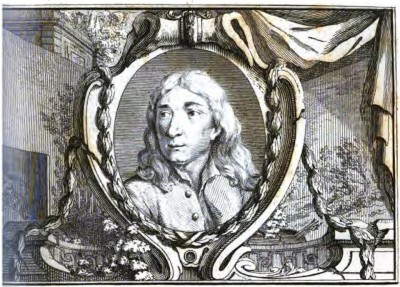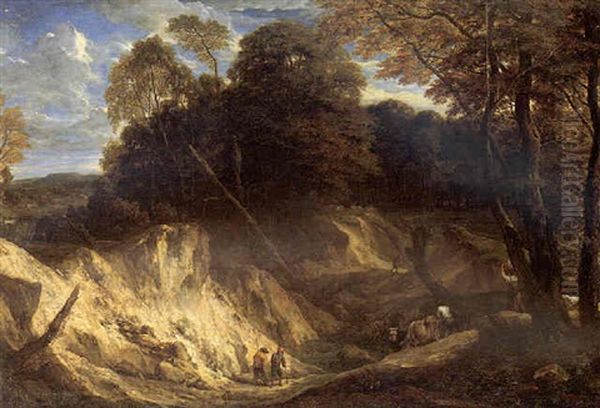
Cornelis Huysmans, a significant figure in the Flemish school of painting, carved a distinct niche for himself primarily as a landscape artist during the late Baroque period. Active mainly in the late 17th and early 18th centuries, his work forms a bridge between the established traditions of Flemish landscape and emerging sensibilities, characterized by a unique blend of local influence and an appreciation for Italianate styles, particularly the Venetian school's approach to color and atmosphere. His paintings, often depicting idealized woodland scenes, continue to be admired in major museum collections across Europe.
Early Life and Artistic Formation
Cornelis Huysmans was born in Antwerp in 1648. His father was Hendrik Huysmans, identified as a builder (bouwmeester), and his mother was Catharina van der Meiden. The Huysmans family appears to have had artistic inclinations beyond Cornelis himself. Notably, his elder brother, Jan Baptist Huysmans (1646–1716), was also a painter, specializing in landscapes and genre scenes, suggesting an environment where artistic pursuits were familiar, even if his father's profession lay elsewhere. Some sources even suggest Jan Baptist may have been an early teacher or influence on Cornelis.
Huysmans received his initial artistic training in his native Antwerp. Early biographical accounts, such as those by Arnold Houbraken, mention that he studied with the history painter Gillis Backereel and later with Frans Woutering. This grounding in figure and history painting likely provided a solid foundation, even though his mature career would focus predominantly on landscape. Seeking further development, Huysmans moved to Brussels.
In Brussels, Huysmans entered the workshop of the prominent landscape painter Jacques d'Arthois (1613–1686). This apprenticeship proved highly influential. D'Arthois was a leading figure in Flemish landscape painting, known for his large-scale, often dramatic depictions of the Sonian Forest near Brussels. His style, characterized by dynamic compositions and a rich, often dark palette, left a discernible mark on Huysmans' own approach to depicting woodland interiors and expansive vistas. Some early sources also mention studies under figures like Pieter de Gasts and an unspecified 'Pieter', though these connections lack confirmation in the official records of the Guild of Saint Luke.
The Development of a Distinctive Style

While trained in the Flemish tradition, Cornelis Huysmans developed a personal style that set him apart. His primary focus became the landscape, often rendered with a warmth and atmospheric depth that drew comparisons to the Venetian school of painting. Unlike the meticulous detail often found in Dutch landscapes of the same period, Huysmans employed broader brushstrokes and a richer, more painterly technique. His palette favored warm, deep tones – earthy browns, resonant greens, and golden light – creating evocative moods in his scenes.
This affinity for Venetian color and light, perhaps inspired by artists like Titian whose landscape backgrounds were influential, contributed to his work being described as having an "international" flavor. He successfully integrated the lessons learned from Jacques d'Arthois, particularly in the rendering of dense forests and undulating terrain, with a softer, more atmospheric handling influenced by southern European art. This synthesis resulted in landscapes that felt both grounded in Flemish tradition and imbued with an idealized, almost poetic quality.
His compositions often feature winding paths leading the viewer's eye into deep woodland interiors, framed by majestic trees. He frequently incorporated small figures – shepherds, travelers, or mythological characters – into his landscapes. These figures, known as staffage, add narrative interest and scale but remain subordinate to the grandeur of the natural setting. The interplay of light and shadow is a key element, with sunlight often filtering through leaves or illuminating clearings, creating dynamic contrasts and enhancing the sense of depth.
Subject Matter and Key Works
Cornelis Huysmans dedicated most of his artistic output to landscape painting. His preferred subjects were idealized woodland scenes, often inspired by the forests around Brussels and Mechelen, but transformed through his artistic vision. These were not typically topographical representations but rather compositions designed to evoke a particular mood, often one of rustic tranquility or sylvan majesty. Occasionally, he integrated religious or mythological narratives into his landscapes, following a long tradition in Flemish art established by masters like Peter Paul Rubens and Jan Brueghel the Elder.
One notable example of his work is Jacob Returning to Canaan with his Family, housed in the Tula State Museum of Art in Russia. This painting showcases his ability to combine a biblical narrative with an expansive, atmospheric landscape setting. The figures are integrated naturally into the scene, which is dominated by rolling hills and carefully rendered trees under a warm sky, typical of his style.
Another work sometimes attributed to him, Forest and Castle, exemplifies the combination of natural scenery and architectural elements, though specific details and dating of such works can sometimes be complex. His skill in depicting the textures of foliage, the ruggedness of terrain, and the effects of light is consistently evident. The Metropolitan Museum of Art in New York holds at least two landscapes by Huysmans, testament to his recognition within major international collections.
However, the condition of some works can present challenges for modern viewers. For instance, a painting titled Herds in a Hilly Landscape has been noted to suffer from changes in color balance due to the natural oxidation of pigments over time and potentially past cleaning processes. Such factors can sometimes exaggerate contrasts or alter the subtle tonal harmonies originally intended by the artist, reminding us of the physical history embedded within artworks.
Huysmans in the Context of Flemish and European Art
Cornelis Huysmans operated within the rich tradition of Flemish Baroque landscape painting, which had reached a high point with Peter Paul Rubens and Jan Brueghel the Elder earlier in the 17th century. His direct master, Jacques d'Arthois, was himself a major exponent of this tradition, alongside contemporaries like Lucas van Uden and Lodewijk de Vadder, who also specialized in depicting the Brabantine forests. Huysmans absorbed these influences but steered the genre towards a slightly softer, more decorative sensibility that anticipated Rococo aesthetics.
His brother, Jan Baptist Huysmans, worked in a similar vein, contributing to the family's artistic presence. Cornelis also took on pupils, ensuring the continuation of his style and techniques. Arnold Houbraken identifies Augustinus Terwesten and Christoffel Lubieniecki as artists who studied with him, carrying his influence into the next generation.
While firmly rooted in Flanders, Huysmans' style, with its Venetian undertones, reflects the broader European artistic currents of the time. The idealizing tendencies in his work resonate with the classical landscapes being produced in Italy by artists like Claude Lorrain and Nicolas Poussin, although Huysmans maintained a distinctly Flemish character in his handling of paint and depiction of nature. His work stands somewhat apart from the prevailing trends in the neighboring Dutch Republic, where landscape painters like Jacob van Ruisdael and Meindert Hobbema often focused on more naturalistic, detailed representations of their local environment. Huysmans' approach was generally more painterly and idealized.
Later Career, Reception, and Legacy
After his time in Brussels, Cornelis Huysmans settled in Mechelen (Malines) around 1706, where he remained active until his death. He seems to have enjoyed considerable success during his lifetime. He became a master in the Brussels Guild of Saint Luke in 1675 and served as its dean in 1706-07 before his move to Mechelen. He continued to paint prolifically in Mechelen, becoming a respected figure in the local art scene.
However, artistic tastes shifted, and later critics sometimes found his style less appealing. Some commentary, possibly reflecting later Neoclassical or Romantic sensibilities, criticized what they perceived as an "excessive" or mannered quality in his forms, deeming his style somewhat "outdated" by the standards of subsequent generations. His "international" style, blending Flemish and Italianate elements, also meant that during periods of strong nationalist focus in art history (particularly in the 19th and early 20th centuries), he was sometimes overlooked in favor of artists seen as more purely representative of a national school.
Despite these fluctuations in critical fortune, a reappraisal began in the mid-20th century. Art historians started to recognize the quality and distinctiveness of his work, appreciating his skillful compositions, his mastery of color and light, and his significant role within the later Flemish landscape tradition. His ability to create immersive, atmospheric woodland scenes found renewed appreciation.
Cornelis Huysmans died in Mechelen on June 1, 1727. Today, his paintings are held in numerous prestigious museums worldwide, including the Louvre in Paris, the Prado Museum in Madrid, the Hermitage Museum in Saint Petersburg, the Metropolitan Museum of Art in New York, and major collections in Brussels, Antwerp, Vienna, and London. His enduring presence in these institutions confirms his status as a significant and accomplished master of Flemish landscape painting.
Conclusion
Cornelis Huysmans stands as a key figure in the evolution of Flemish landscape painting during the late 17th and early 18th centuries. Emerging from the powerful tradition shaped by artists like Rubens and his own teacher Jacques d'Arthois, Huysmans forged a distinctive path. He skillfully blended the robust naturalism of Flemish art with a warmer, more atmospheric sensibility inspired by Venetian colorists. His idealized woodland scenes, characterized by rich palettes, painterly brushwork, and evocative use of light, captured a unique mood of rustic grandeur and tranquility. Though his critical reception has varied over time, his technical skill and artistic vision have secured his place as an important master whose works continue to engage viewers in museums around the globe.